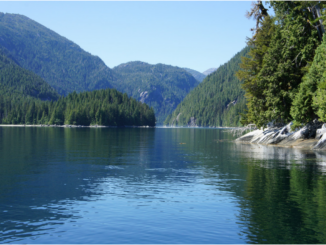Shelly Glover, Minister of Canadian Heritage and Official Languages and Minister responsible for Manitoba, and Manitoba Premier Greg Selinger visited Churchill to announce an investment of $22.1 million to build a highly innovative research facility to be located in the Port of Churchill, Canada’s only Arctic deepwater port.
The Churchill Marine Observatory will be a multidisciplinary research facility where researchers will study the detection, impact and mitigation of oil spills in sea ice and investigate issues facing Arctic marine transportation. The research will help address technological, scientific and economic issues pertaining to Arctic marine transportation and oil and gas exploration and development throughout the Arctic and position Canada and Churchill as global leaders in protecting the fragile northern ecosystem.
This unique facility will bring together researchers from the universities of Manitoba, Calgary, Victoria, Laval, Dalhousie and Washington and from federal government departments. One of its key features will be two saltwater subpools designed to simultaneously accommodate various scenarios of oil spills in sea ice. Scientists will be able to study oil in actual Arctic seawater and sea ice. An environmental observing system will also be built on the Churchill estuary along the main shipping channel across Hudson Bay and Strait, providing a state-of-the-art monitoring system that will strengthen Canada’s technological capacity to protect the Arctic environment.
Quick facts
- The research infrastructure funding is provided through the Canada Foundation for Innovation (CFI), which will invest $12.4 million, while the Province of Manitoba has committed almost $9.7 million over four years.
- The CFI’s Innovation Fund supports transformative research infrastructure projects that enable the discoveries and innovations that improve the lives of Canadians. As a result of Government of Canada investments made through the CFI, universities, colleges and research hospitals across the country are equipped with state-of-the-art tools and laboratories that enable researchers to discover and innovate.
- Manitoba’s contribution reflects its commitment to advancing research on climate change and sustaining northern ecosystems. It also demonstrates support of the University of Manitoba and its world-leading Arctic research and of Churchill as a gateway to the Arctic.
- In Economic Action Plan 2015, the Government of Canada proposed an additional investment of $1.33 billion in the CFI, the largest single investment ever made to support research infrastructure in the country.
Quotes
“Through Economic Action Plan 2015, our government is ensuring science and technology continue to create jobs and prosperity and improve the quality of life of Canadians across the country. Today’s investment in state-of-the-art infrastructure at universities, hospitals and other research institutions provides a foundation for the cutting-edge research that benefits and changes the lives of Canadians.”
– Ed Holder, Minister of State (Science and Technology)
“Today, I am pleased to announce our government’s investment in advanced research is benefiting the University of Manitoba and the wider Churchill community. The advances made here will help make Canada a world leader in detecting oil spills in sea ice and mitigating their effects, while improving the quality of life of Canadians.”
– Shelly Glover, Minister of Canadian Heritage and Official Languages
“In today’s highly competitive research environment, university researchers need access to the best tools and facilities to make them stand out. The Churchill Marine Observatory will give marine scientists, including those at the University of Manitoba, the opportunity to develop practical methods that will help us be better stewards of the North.”
– Gilles Patry, President and CEO, Canada Foundation for Innovation
“Churchill is the perfect location for this cutting-edge research from our experts at the University of Manitoba and their partners. Understanding the effects of global climate change and protecting this fragile ecosystem, as well as greater comprehension of the disappearance of sea ice in the summer, are vital for all citizens, not just in Manitoba or Canada but across our planet.”
– Greg Selinger, Premier of Manitoba
“An investment of this magnitude bodes well for our community’s ongoing sustainability efforts, and as we experience climate change, our community will continue to be on the leading edge of scientific research.”
– Michael Spence, Mayor of the Town of Churchill
“We are proud to invest, with our partners, in the Churchill Marine Observatory and excited about the unique opportunities and possibilities that the researchers have ahead of them.”
– Christina Weise, CEO, Research Manitoba
“Arctic system science and climate change is one of the University of Manitoba’s signature areas of research excellence, and the Churchill Marine Observatory will enable our scientists, working in collaboration with partners around the world, to push forward knowledge and understanding in this important field. Their research will be crucial to mitigating and adapting to the effects of a changing climate on Canada’s Arctic and the world.”
– David Barnard, President and Vice-Chancellor, University of Manitoba
“The Churchill Marine Observatory will be a globally unique facility designed to support detailed investigations of oil, and other transportation-related contaminants, in Arctic sea ice using a purpose built Oil in Sea Ice Mesocosm, or OSIM.These small scale OSIM studies will then be upscaled to the entire Arctic using a highly coupled environmental observing system. Taken as an amalgam, the Churchill Marine Observatory will provide new knowledge and environmental technologies required for the detection of oil or contaminant spills in sea ice and the mitigation of their impact, directly benefiting policy development and technological innovation in Manitoba, Nunavut, Canada and, indeed, the circumpolar world.”
– David Barber, Project Lead and Canada Research Chair in Arctic-System Science, University of Manitoba




Be the first to comment